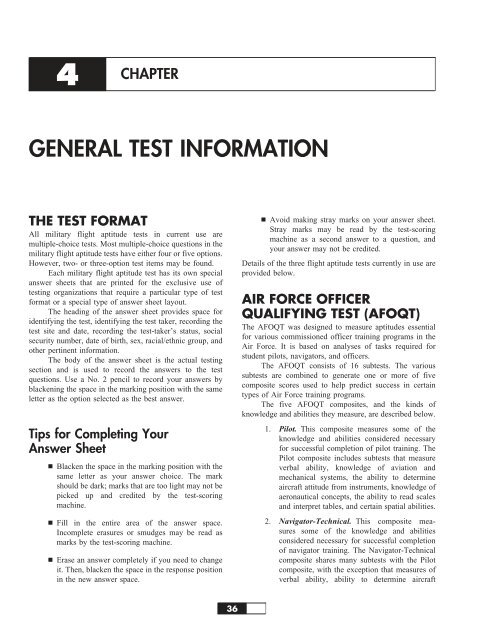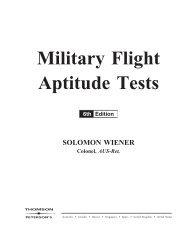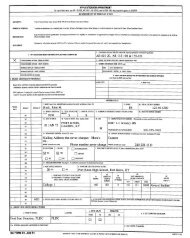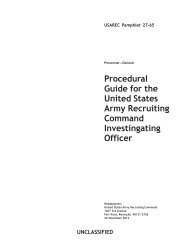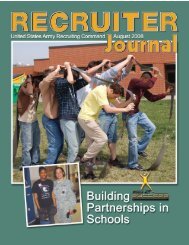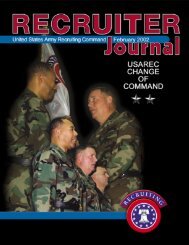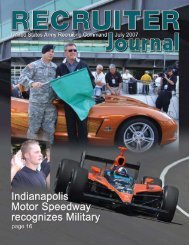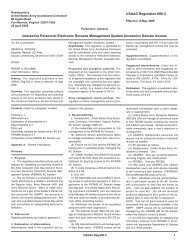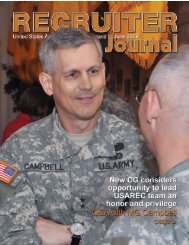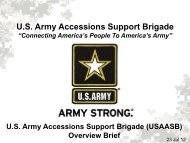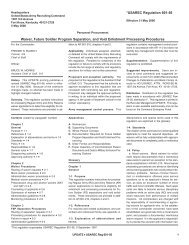Military Flight Aptitude Tests - USAREC - U.S. Army
Military Flight Aptitude Tests - USAREC - U.S. Army
Military Flight Aptitude Tests - USAREC - U.S. Army
Create successful ePaper yourself
Turn your PDF publications into a flip-book with our unique Google optimized e-Paper software.
4<br />
CHAPTER<br />
GENERAL TEST INFORMATION<br />
THE TEST FORMAT<br />
All military flight aptitude tests in current use are<br />
multiple-choice tests. Most multiple-choice questions in the<br />
military flight aptitude tests have either four or five options.<br />
However, two- or three-option test items may be found.<br />
Each military flight aptitude test has its own special<br />
answer sheets that are printed for the exclusive use of<br />
testing organizations that require a particular type of test<br />
format or a special type of answer sheet layout.<br />
The heading of the answer sheet provides space for<br />
identifying the test, identifying the test taker, recording the<br />
test site and date, recording the test-taker’s status, social<br />
security number, date of birth, sex, racial/ethnic group, and<br />
other pertinent information.<br />
The body of the answer sheet is the actual testing<br />
section and is used to record the answers to the test<br />
questions. Use a No. 2 pencil to record your answers by<br />
blackening the space in the marking position with the same<br />
letter as the option selected as the best answer.<br />
Tips for Completing Your<br />
Answer Sheet<br />
n Blacken the space in the marking position with the<br />
same letter as your answer choice. The mark<br />
should be dark; marks that are too light may not be<br />
picked up and credited by the test-scoring<br />
machine.<br />
n Fill in the entire area of the answer space.<br />
Incomplete erasures or smudges may be read as<br />
marks by the test-scoring machine.<br />
n Erase an answer completely if you need to change<br />
it. Then, blacken the space in the response position<br />
in the new answer space.<br />
36<br />
n Avoid making stray marks on your answer sheet.<br />
Stray marks may be read by the test-scoring<br />
machine as a second answer to a question, and<br />
your answer may not be credited.<br />
Details of the three flight aptitude tests currently in use are<br />
provided below.<br />
AIR FORCE OFFICER<br />
QUALIFYING TEST (AFOQT)<br />
The AFOQT was designed to measure aptitudes essential<br />
for various commissioned officer training programs in the<br />
Air Force. It is based on analyses of tasks required for<br />
student pilots, navigators, and officers.<br />
The AFOQT consists of 16 subtests. The various<br />
subtests are combined to generate one or more of five<br />
composite scores used to help predict success in certain<br />
types of Air Force training programs.<br />
The five AFOQT composites, and the kinds of<br />
knowledge and abilities they measure, are described below.<br />
1. Pilot. This composite measures some of the<br />
knowledge and abilities considered necessary<br />
for successful completion of pilot training. The<br />
Pilot composite includes subtests that measure<br />
verbal ability, knowledge of aviation and<br />
mechanical systems, the ability to determine<br />
aircraft attitude from instruments, knowledge of<br />
aeronautical concepts, the ability to read scales<br />
and interpret tables, and certain spatial abilities.<br />
2. Navigator-Technical. This composite measures<br />
some of the knowledge and abilities<br />
considered necessary for successful completion<br />
of navigator training. The Navigator-Technical<br />
composite shares many subtests with the Pilot<br />
composite, with the exception that measures of<br />
verbal ability, ability to determine aircraft


